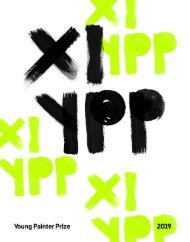XII Young Painter Prize Book
You also want an ePaper? Increase the reach of your titles
YUMPU automatically turns print PDFs into web optimized ePapers that Google loves.
One of the minds behind the world-famous<br />
Eames designs, Ray Eames, was<br />
herself a classically trained painter. She<br />
said that she never gave up painting, she<br />
just changed her pallet. Painting is not a<br />
strictly defined form; it can manifest itself<br />
as an artistic vision or worldview. It<br />
can be present in the way an artist uses<br />
color, artistic gestures, space, and even<br />
time. It can be a performative movement<br />
that incorporates painterly qualities - the<br />
aggressiveness or softness of the brush.<br />
There are definitely dozens of artists who<br />
work with sculpture, installations, performances,<br />
photo and video art who from my<br />
point of view are painters using different<br />
kind of canvas.<br />
Pop artists like Roy Lichtenstein took one<br />
of painting’s most important tools –the<br />
brushstroke - and transformed it into a<br />
mechanical, cold reproduction, or in other<br />
words created a gravestone for it. Now,<br />
apart from art that is strongly influenced<br />
by the presence of the internet, there are<br />
also certain forms that are reminiscent of<br />
modernism. The brush stroke has suddenly<br />
not just broken free from Lichtenstein’s flat<br />
image in all its juicy textures and liquidity,<br />
but it has also jumped out of the canvas<br />
and become a sculptural entity itself.<br />
The “fluidity” 2 we are experiencing now is<br />
not just connected with the fluid borderlines<br />
that exist between different art forms.<br />
It’s time itself that has triggered a different<br />
look at the world that hopefully won’t get<br />
jammed by political “earthquakes” and<br />
pandemics. Physical mobility and internet<br />
connections have changed the way we<br />
perceive our location, our connection with<br />
it, and travel. It has been popular for some<br />
time to revisit history, trying to decolonize<br />
and expand it by filling it with stories of<br />
different marginalized groups including<br />
woman, queer communities and different<br />
cultures and races. Archiving the ghosts<br />
of the past has also become an important<br />
part of the oeuvre of modern painters like<br />
Luc Tuyman, Marlene Dumas and Neo<br />
Rauch, all of whom blend their own personal<br />
micro histories into their works.<br />
A crucial source of liquidity is the influence<br />
of the internet, the streams and surfing<br />
opportunities it has provided, and the flows<br />
of images and information we have experienced.<br />
And then finally there is the post<br />
human movement which forces us to shift<br />
from our position of center and reconnect<br />
with other living things and the world as<br />
such. This idea about reconnecting and<br />
fluidity is very much present in the poetic<br />
texts of the essayist Astrida Neimanis,<br />
which are dedicated to the topic of hydrofeminism<br />
3 . Here she speaks of bodies being<br />
water which, connected in an imaginably<br />
tight yet fluid way, allow us to be<br />
free of dogmas and flow where we need<br />
to.<br />
2 I borrowed the term from sociologist and philosopher<br />
Zygmunt Bauman. He introduced late modernity as “liquid”<br />
modernity which is marked by the global capitalist economies<br />
and by the information revolution.<br />
3 Neimanis, Astrida. Bodies of Water. Posthuman Feminist<br />
Phenomenology. - Lodon: Bloomsbury Academic, 2017.





